- Getting around Lijiang. Dont stay in the Old Towns more than 2 days, there is nothing to do. KRISS Oct 9, 2013 05:46
- 2013 Beijing Temple Fair BENNYLAU Feb 26, 2013 03:29
- Malaysian traveling from KUL - LAX vis Shanghai PVG ZATI_DY Jan 3, 2013 20:15
Suzhou: The Little Italy of China
- Views: 34931
- |Vote: 0 0
- |Add to Favorites
- |Recommend to Friends
A Memorable Name
Who first named it the Venice of the Orient? Could it have been that famous Venetian explorer and Emperor’s favorite who left his own waterways behind to be pulled into the tidal rhythms of 12th century China?
Perhaps, though we’ll probably never know for sure. One thing that is for sure though is that this phrase has become the eternal byline for Suzhou, a delicate ballerina of a city in the branching grasp of the Yangtze River Delta. And it’s not called the Venice of the Orient simply because Marco Polo fell ill with a bout of homesickness—this graceful city is laced with so many serpentine waterways that the inhabitants are said to sleep upon pillows of water.
Water Towns
Suzhou, located in Jiangsu province about an hour and a half inland from Shanghai, built water canals to chessboard its streets in the 6th century so that they might balance more firmly upon the unstable fingers of the Yangtze’s arm in its long reach toward the sea. Several other towns and cities in the region took up the same practice, creating China’s region of Water Towns.
A Water Town in China is not simply an expression of geographical fact but has become a cultural and aesthetic descriptor as well. China’s water towns are known for their muted colors and depth of reflection; for their white-washed walls and gray roof tiles; for solid lines and the tender beckoning curve of bridges arching over canalways. Their inhabitants have been masters of calligraphy, fine art, embroidery, silk weaving, poetry, garden-making and tea cultivation: areas of expertise that all require an attention to detail that only the multi-faceted gilding a web of waterways could inspire.
Shopping Bazaar
Though Suzhou is most famous for its scores of gardens, what many people don’t know is that the art of the Chinese Garden stems from the Daoist concept of uniting scenery and serenity. So we started our exploration of the city by paying homage to Suzhou’s Daoist Temple of Mystery (Xuan Miao Guan).
The Temple of Mystery, despite sounding like it is perched atop some mist-shrouded mountain peak, is actually located in the commercial heart of Suzhou. Guan Qian Street, Suzhou’s famous pedestrianized shopping bazaar, butterfly-clasps Renmin Lu and Lundun Lu, Suzhou’s two main north-south arteries. Guan Qian literally means “Temple Facing Street” because historically the temple was the focal point for traveling magicians, craftsmen, and merchants. They set up camp along the avenue and the trend has continued over the ages. Today, Guan Qian Street is still the best place to find both modern conveniences and traditional Suzhou food and wares.
Ancient Well of Five Dynasties
Xuan Miao Temple was originally built in 276, after the fall of the Han Dynasty. Between the main gate of the temple and the large hall, visitors shouldn’t miss a peek into the Ancient Well of the Five Dynasties. The well was unearthed in 1999 during renovation of the main hall of the temple. During renovation over 30 artifacts dating as far back as the Tang Dynasty were found on the green slabstone at the bottom of the well. Encircled by carvings of dragons, the water within the well, though clean, looks black as it bores into the earth. There’s no telling what mysteries you’ll uncover if you look directly into its depths.
Worshipers and Protectors
The largest building on the temple grounds is the Hall of the Three Pure Worshipers, so named for the Daoist Heads of State: Laozi, the founder of Daoism, flanked by the Yellow Emperor and the Jade Emperor. Behind them, along the sides and back wall of the temple, lies the highlight of the Xuan Miao Temple: a constellation of Daoist Protector Figures. Daoist Protector Figures, or Tai Sui, are the sentinels to all those born within a given year. There are 60 different Protectors, one for each year of the time-cycle of Chinese years. The ancient Chinese method of calculating the progression of years was not done the way it is done in the West, using A.D and B.C/B.C.E. Instead, the Chinese chart the years by Jia Zi, which takes the 12 animals of the Chinese Zodiac multiplied by 5 marker years. Every 60 years the cycle starts over, thus the Protector of 1931 is also the Protector of 1991.
Through the Ages
Though there are other halls within the temple complex that are interesting, they are easily overlooked. The temple courtyard is large and the atmosphere is casual, making the temple more a place for companionable gathering than for pensive contemplation. Merchants still schlep their wares in little stalls around the main hall, friends meet to chat, mothers gossip, old folks set up games of mah jong or cards, and young lovers canoodle under the shade of trees. A bronze statue of an old traveling merchant lies in the temple courtyard, paying testament to the fact that in ancient China, as today, the temple served dual duty as a place of worship and a center for commerce and community
A Scholar's Haven
One hall that shouldn’t be missed, even if you do get distracted by the wares and people-watching, is the Literature God’s Temple, or Wen Chang Dian. In the ancient days, scholars who studied and sat for the Imperial examination would come to the Literature God’s temple to pray. Wen Shu Pusa, the God of Literature, chose the official rank of scholars in Imperial China and protected the fate of those who were chosen. Today it’s not unusual to see concerned parents and nervous students paying homage to the Literature God before sitting the exams in their high schools or universities. Frustrated novelists or journalists with writer’s block might also be seen pacing back and forth on the temple grounds, muttering to themselves and lighting incense.
A Unique Experience
The Xuan Miao Temple is best seen in the late afternoon, when the slipping sunlight ignites the gold-painted temple walls. In contrast to the black-tiled roofs, the effect is mesmerizing and ferments the atmosphere of Mystery around the temple. Before leaving, however, stop into the little tea-house on the western side of the temple grounds for a traditional Suzhou storytelling.
This little tea house, tucked into the melee of shops and stalls, appears on the surface to be a tourist trap. But it may be one of the last genuine storyteller tea-shops of its kind. The tea-house is mostly filled with aging Chinese who raptly listen to the storyteller’s cadenced performance with intermittent slurps of hot tea. Despite the fact that we couldn’t understand a word of the story, it was easy to downshift into entranced enjoyment. The storyteller was an old man whose gravelly voice pitched and rolled as if it were climbing a mountain. He wore a full Mandarin-style robe with a high collar and full sleeves. He sat on a stool and spoke into a microphone that had reverb-effect, which gave the story a voiceover air of narrator-wise-man. He sat with his chin slightly raised, and when the story reached climactic parts he’d stand up, stool tottering backwards, and start waving his arms like a giant crane about to snatch a fish.
It Comes With a Price
Though the storyteller tea-house is an experience that can’t be missed, visitors should be wary of the wily proprietress and her deceptive price-quoting abilities. A “pot” of tea, which she quoted at 30RMB each, turned out to be two cups of tea, each at 30RMB. Though the tea was delicious and the atmosphere unrivaled, the experience soured a bit by being had. But, as storytellers are apt to do, we soon forgot about the cheating crone in the corner and sat sipping, transported, as the storyteller flapped his arms and pitched his voice and told his tale.
Everyone Loves a Mystery
As evening fell we stepped out of the tea house and left the temple grounds, entering into the commercialized pastiche of Guan Qian street. One of the best places to sample traditional Suzhou fare, we settled in to absorb the budding night life and search out a restaurant.
Suzhou’s Temple of Mystery, though just another of China’s temples, is not one to be missed. Though there are other attractions in Suzhou that may be more alluring, the Temple of Mystery has features unique to it that can’t be found in other temples across China. Suzhou’s Daoist Temple is Xuan Miao—there’s a mystery in store for everyone.
Information
Getting There:
Train from Shanghai to Suzhou: 24RMB
Pedicab from Train Station to City Center: 10-15RMB
Pedicabs are a cheap and convenient way to get around the center of the city. Bicycles can be rented for about 10RMB per day. City buses are also a good way to get from one end of the city to another 1.5-2RMB (depending on destination)
Accomodation:
Nice hotels can be found from 100-160RMB per night. We asked our Pedicab driver for a recommendation and he took us to a cheap but nice hotel almost directly behind the Temple of Mystery.
Cost:
Temple of Mystery Entrance fee: 10RMB
Storyteller Tea House: storytelling free with a 30RMB cup of tea (unlimited water refills)
.




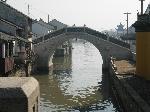
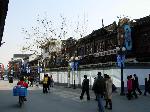
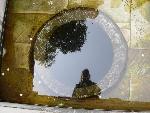


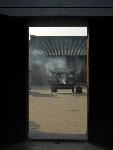

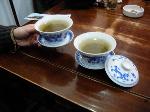
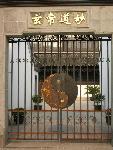

 Copyright © 1998-2026 All rights reserved.
Copyright © 1998-2026 All rights reserved.
1.
Mar 4, 2007 00:44 Reply
KATIENCHINA said:
Another great article Tory! I felt like I was back in home sweet home, Jiangsu! =)
2.
Feb 25, 2007 17:43 Reply
ROGERINCA said:
Hi Stocktov,
I really enjoy your writing style and your presentation.
Unlike a recent ‘drive-by’ Article [deposited] here, your commentary is always uplifting, very informative, colorful, descriptive and balanced.
I think TCG has made some very fine choices in their selection of regular Columnists herein !!!
Thank you !! :)